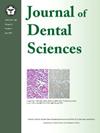Effects of various aging modes on the optical properties of zirconia with different yttria concentrations in coffee and tea
IF 3.1
3区 医学
Q1 DENTISTRY, ORAL SURGERY & MEDICINE
引用次数: 0
Abstract
Background/purpose
The esthetic performance of dental zirconia may be affected by both material composition and environmental exposure. This study aimed to evaluate how different aging conditions-hydrothermal aging and thermal cycling-influenced the optical properties of dental zirconia containing varying yttria concentrations (3Y-TZP, 4Y-TZP, and 5Y-TZP) in coffee and tea.
Materials and methods
A total of 120 zirconia specimens were prepared using three yttria concentrations. Each group was subjected to four artificial aging conditions: storage in coffee or tea at 37 °C for 1 and 6 months (hydrothermal aging), or 10,000 and 50,000 cycles of thermal cycling between 5 °C and 55 °C. Optical parameters (L∗, a∗, b∗) and color differences (ΔE00) were measured using a spectrophotometer and calculated using the CIEDE2000 formula. Data were analyzed using ANOVA and Tukey's HSD test (α = 0.05).
Results
Zirconia with higher yttria content exhibited more pronounced color changes (P < 0.001). Aging in tea resulted in minimal color variation regardless of yttria content or aging mode. In coffee, the ΔE00 values of the HT (3Y-TZP), ST (4Y-TZP), and XT (5Y-TZP) groups ranged from 3.5, 7.0 and 8.5, respectively (P < 0.0001). In tea, the values ranged from 1.1 for both HT and ST, and from 3.1 for XT (P < 0.0001).
Conclusion
Both yttria concentration and aging conditions significantly influenced the color stability of zirconia. Hydrothermal aging had a greater impact than thermal cycling, especially in coffee. These findings suggest that material composition and exposure environment should be carefully considered when selecting zirconia for esthetic dental restorations.
不同老化方式对咖啡和茶中不同氧化钇浓度氧化锆光学性质的影响
背景/目的牙科氧化锆的美观性能可能受到材料成分和环境暴露的双重影响。本研究旨在评估不同老化条件(水热老化和热循环)对咖啡和茶中含不同钇浓度(3Y-TZP, 4Y-TZP和5Y-TZP)的牙科氧化锆光学性质的影响。材料与方法采用三种氧化钇浓度制备了120个氧化锆样品。每一组都经历了四种人工老化条件:在37°C的咖啡或茶中储存1和6个月(水热老化),或在5°C至55°C之间进行10,000和50,000次热循环。使用分光光度计测量光学参数(L∗,a∗,b∗)和色差(ΔE00),并使用CIEDE2000公式计算。数据分析采用方差分析和Tukey’s HSD检验(α = 0.05)。结果氧化锆中钇含量越高,颜色变化越明显(P <;0.001)。无论黄含量或陈化方式如何,茶的陈化导致的颜色变化都很小。在咖啡中,HT (3Y-TZP)、ST (4Y-TZP)和XT (5Y-TZP)组的ΔE00值分别为3.5、7.0和8.5 (P <;0.0001)。在茶叶中,高温和高温的值为1.1,高温和高温的值为3.1 (P <;0.0001)。结论氧化钇浓度和陈化条件对氧化锆的颜色稳定性有显著影响。水热老化比热循环的影响更大,尤其是在咖啡中。因此,在选择氧化锆材料进行口腔修复时,应仔细考虑材料成分和暴露环境。
本文章由计算机程序翻译,如有差异,请以英文原文为准。
求助全文
约1分钟内获得全文
求助全文
来源期刊

Journal of Dental Sciences
医学-牙科与口腔外科
CiteScore
5.10
自引率
14.30%
发文量
348
审稿时长
6 days
期刊介绍:
he Journal of Dental Sciences (JDS), published quarterly, is the official and open access publication of the Association for Dental Sciences of the Republic of China (ADS-ROC). The precedent journal of the JDS is the Chinese Dental Journal (CDJ) which had already been covered by MEDLINE in 1988. As the CDJ continued to prove its importance in the region, the ADS-ROC decided to move to the international community by publishing an English journal. Hence, the birth of the JDS in 2006. The JDS is indexed in the SCI Expanded since 2008. It is also indexed in Scopus, and EMCare, ScienceDirect, SIIC Data Bases.
The topics covered by the JDS include all fields of basic and clinical dentistry. Some manuscripts focusing on the study of certain endemic diseases such as dental caries and periodontal diseases in particular regions of any country as well as oral pre-cancers, oral cancers, and oral submucous fibrosis related to betel nut chewing habit are also considered for publication. Besides, the JDS also publishes articles about the efficacy of a new treatment modality on oral verrucous hyperplasia or early oral squamous cell carcinoma.
 求助内容:
求助内容: 应助结果提醒方式:
应助结果提醒方式:


